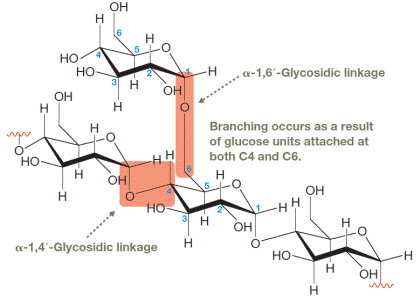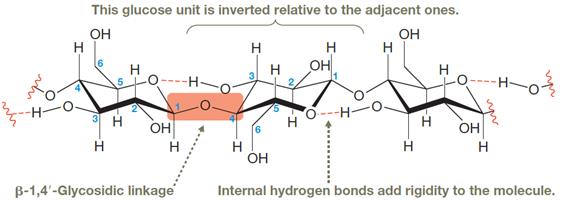
Concept explainers
Interpretation:
There is one glycosidic linkage not highlighted in Figure 26-52 and another in Figure 26-53. Each one is to be identified, and the kind of glycosidic linkage is to be classified.

![]()

![]()
Concept introduction:
Polysaccharides are long chains of carbohydrate molecules. The monosaccharide units are combined together by glycosidic bond to form polysaccharides. Figure 26-52 is that of amylopectin, and Figure 26-53 is that of cellulose.
Amylopectin, a branched storage polysaccharide, consists of a main chain that consists of glucose units joined by
Cellulose, a structural polysaccharide, is the main component of plants’ cell walls, making up about one-third of all plant matter. Cellulose consists of long, unbranched chains of d-glucose. In cellulose the glucose units are linked by
Want to see the full answer?
Check out a sample textbook solution
Chapter 26 Solutions
Organic Chemistry: Principles And Mechanisms: Study Guide/solutions Manual (second)
- Write the calculate the reaction quotient for the following system, if the partial pressure of all reactantsand products is 0.15 atm: NOCl (g) ⇌ NO (g) + Cl2 (g) H = 20.5 kcalarrow_forwardComplete the spectroscopy with structurearrow_forwardcould you answer the questions and draw the complete mechanismarrow_forward
- Complete the spectroscopy with structurearrow_forwardCalculate the reaction quotient for the reaction:NaOH (s) ⇌ Na+ (aq)+ OH- (aq) + 44.4 kJ [Na+] = 4.22 M [OH-] = 6.41 Marrow_forwardGiven the following concentrations for a system, calculate the value for the reaction quotient: Cl2(g)+ CS2(g) ⇌ CCl4(g)+ S2Cl2(g) Cl2 = 31.1 atm CS2 = 91.2 atm CCl4 = 2.12 atm S2Cl2 = 10.4 atmarrow_forward
- Match each chemical or item with the proper disposal or cleanup mwthod, Not all disposal and cleanup methods will be labeled. Metal sheets C, calcium, choroide solutions part A, damp metal pieces Part B, volumetric flask part A. a.Return to correct lables”drying out breaker. Place used items in the drawer.: Rinse with deionized water, dry as best you can, return to instructor. Return used material to the instructor.: Pour down the sink with planty of running water.: f.Pour into aqueous waste container. g.Places used items in garbage.arrow_forwardWrite the equilibrium constant expression for the following reaction: HNO2(aq) + H2O(l) ⇌ H3O+(aq) + NO2-(aq)arrow_forwardWrite the reaction quotient for: Pb2+(aq) + 2 Cl- (aq) ⇌ PbCl2(s)arrow_forward
- Write the equilibrium constant expression for the following system at equilibrium: I2 (g) ⇌ 2 I (g)arrow_forwardDon't used hand raiting and don't used Ai solutionarrow_forwardWe learned four factors (ARIO) for comparing the relative acidity of compounds. When two of these factors are in competition, the order of priority is the order in which these factors were covered ("atom" being the most important factor and "orbital" being the least important). However, we also mentioned that there are exceptions to this order of priority. Compare the two compounds and identify the exception. OH PK-4.75 SH PK-10.6 5. "Resonance" is more important than "atom" because the conjugate base of first compound is more stable than the second. "Atom" is more important than "resonance" because the conjugate base of first compound is more stable than the second. "Resonance" is more important than "atom" because the conjugate base of second compound is more stable than the first. "Atom" is more important than "resonance" because the conjugate base of second compound is more stable than the first.arrow_forward
 Introduction to General, Organic and BiochemistryChemistryISBN:9781285869759Author:Frederick A. Bettelheim, William H. Brown, Mary K. Campbell, Shawn O. Farrell, Omar TorresPublisher:Cengage Learning
Introduction to General, Organic and BiochemistryChemistryISBN:9781285869759Author:Frederick A. Bettelheim, William H. Brown, Mary K. Campbell, Shawn O. Farrell, Omar TorresPublisher:Cengage Learning Organic ChemistryChemistryISBN:9781305580350Author:William H. Brown, Brent L. Iverson, Eric Anslyn, Christopher S. FootePublisher:Cengage Learning
Organic ChemistryChemistryISBN:9781305580350Author:William H. Brown, Brent L. Iverson, Eric Anslyn, Christopher S. FootePublisher:Cengage Learning Chemistry for Today: General, Organic, and Bioche...ChemistryISBN:9781305960060Author:Spencer L. Seager, Michael R. Slabaugh, Maren S. HansenPublisher:Cengage Learning
Chemistry for Today: General, Organic, and Bioche...ChemistryISBN:9781305960060Author:Spencer L. Seager, Michael R. Slabaugh, Maren S. HansenPublisher:Cengage Learning


